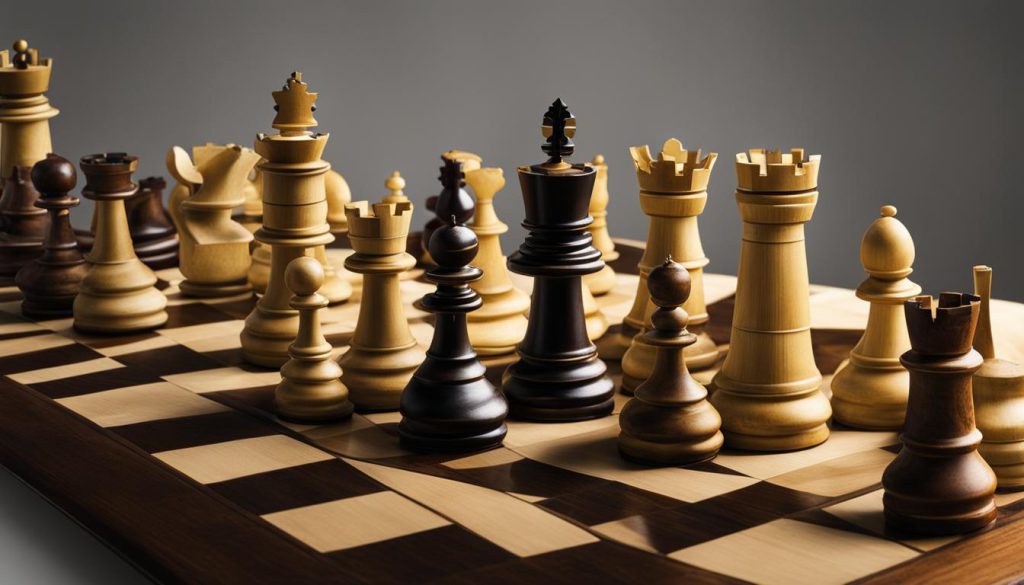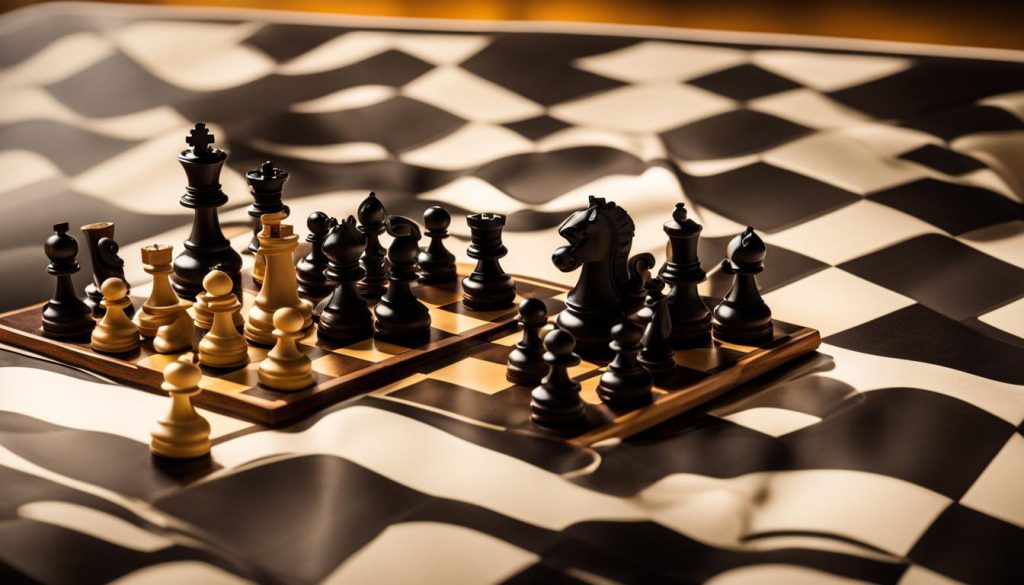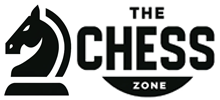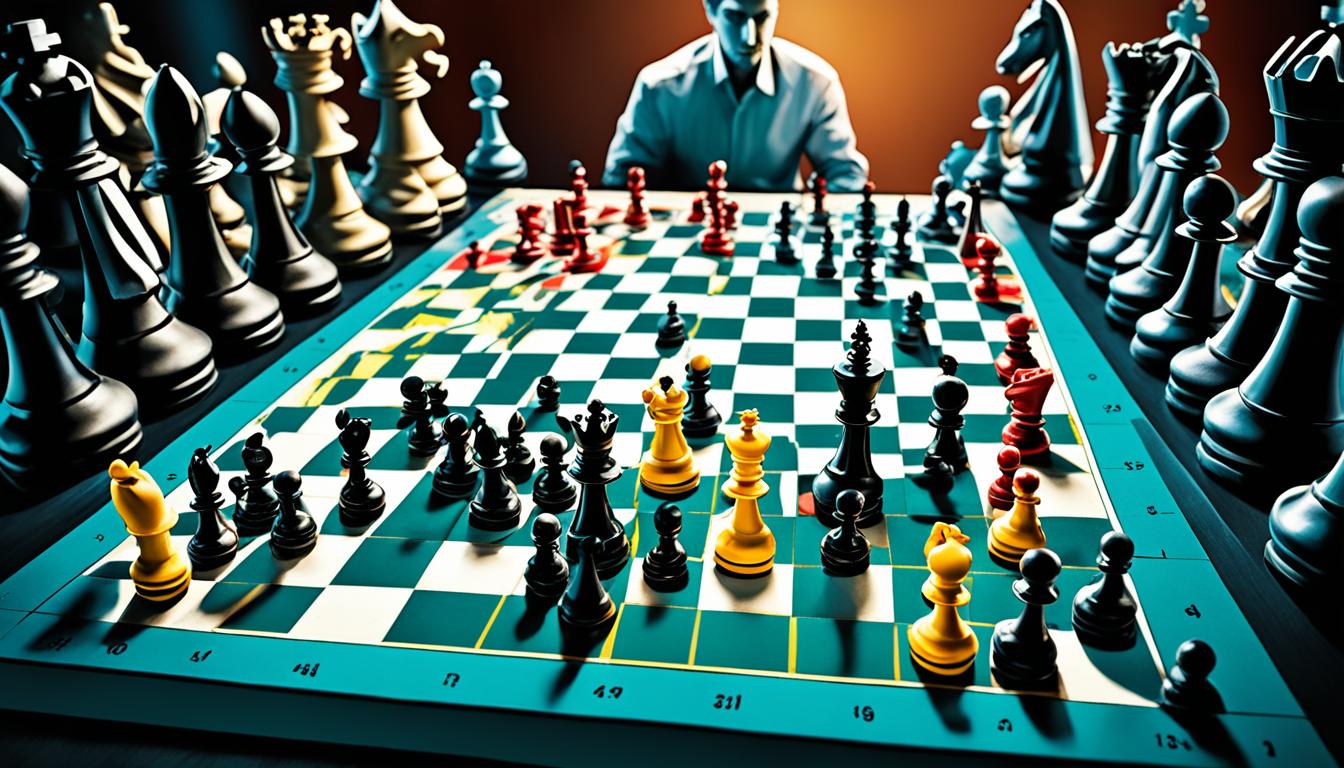The first moves in a chess game are vital. They’re known as the chess opening. These moves can decide who wins or loses. Thus, learning chess openings is key. It sets you up to beat your foes.
This article covers the best chess openings and strategies. We will give expert tips to boost your skills. From new opening variations to crucial tactics, we cover it all. This guide is perfect for beginners and pros alike.
Key Takeaways:
- Mastering chess openings is essential for achieving success in the game.
- Choosing the right openings and strategies can give you a strategic advantage over your opponents.
- Trending opening variations provide fresh approaches to the game and keep you on your toes.
- Understanding key opening tactics is crucial for executing successful opening moves.
- By studying and incorporating expert analysis into your repertoire, you can improve your overall game strategy.
The Importance of Choosing the Right Openings
Choosing the right chess openings is key to winning. It’s important to pick openings that match your skill level and consider how well you make decisions. This helps set up your game for success.
Copying top players’ openings might not work for everyone. Their choices reflect their high skill and deep game knowledge. It’s best to opt for openings that suit your own level and strategy.
Choosing the right openings helps smoothly move from the opening to the midgame and endgame. It lets us play in areas we know well. This boosts our chances of winning.
Also, making smart choices in openings is critical. The first moves lay out the game’s path. Good decisions can give us the upper hand early on.
It’s vital for all players to choose suitable openings and improve how they make decisions. This builds a strong game foundation and strategizes for success.
Consider playing an unfamiliar opening and facing an unexpected move. Without good decision-making, you might falter. But strong skills let you handle surprises and stay in control.
The Impact on Game Strategy
The right openings and smart decision-making shape our overall game strategy. They help position us well for the middlegame and spot tactical opportunities. Making informed choices early sets us up well for later.
Understanding which openings fit our skill level helps us keep getting better. It lets us take on challenges at a good pace. As we improve, exploring more complex openings grows our game knowledge.
Picking the right openings and integrating decision-making skills improves our performance and enjoyment. It sharpens our strategic thinking and adaptability, leading to greater chess success.
Next, we will look at how to build a strong opening repertoire. We’ll also dive into the history of chess openings. This includes strategies from past masters and the shift towards modern openings.
Building a Solid Opening Repertoire
For chess players aiming to get better, mastering openings is key. It lays down the basics for strategic moves and greatly affects the match’s outcome. In this guide, we’ll dive into developing a strong opening repertoire, emphasizing the historical progress of openings.
Begin with a solid base for your repertoire. A good start is to look at openings from chess legends like Paul Morphy. He is famous for his bold and tactical gameplay. Studying these early masters’ openings helps understand timeless strategies and principles.

As you advance in chess, keep up with new opening theories. The rise of hypermodern openings has changed chess strategies. These openings aim to control the center indirectly, unlike traditional methods. Learning about these, like the Reti or Nimzo-Indian Defense, makes your game more dynamic and unpredictable.
Combining classic and hypermodern openings will round out your skills. It lets you find what best matches your style and preferences. Building your repertoire is a continuous journey. Always be open to discovering new strategies and opening variations.
Incorporating Gambits in Your Repertoire
In chess, using gambits in your openings can really help you stand out. Gambits involve sacrificing a pawn or a piece early on. This is to take control and pressure your opponent.
Why add gambits to your game? In amateur play, attacking leads to big benefits. It makes choosing your next move easier than playing defense. It also makes your opponent more likely to mess up.
Being the attacker lets you control the game. From the start, you put your opponent under pressure. This can make it hard for them to respond well.
Attacking has its perks. You get to lead the game’s pace. Your opponent might feel pressured and make mistakes. This lets you take advantage and possibly win the game.
Gambits not only give you a tactical edge but also keep your opponent guessing. They may not know how to handle the gambits you use. This forces them to think harder early in the game.
Choosing the Right Gambits
Pick gambits that fit your play style and overall strategy. Explore different gambits to see their effects and possible results.
Gambits work well in amateur play, but they need good positional play and accurate calculation. Make sure your sacrifices are part of a clear plan. Knowing the reasons behind your gambits helps you make smart choices.
Using gambits means being prepared and flexible. Your opponent might try to counter your aggressive plays. Being able to change your strategy will help you keep an advantage.

| Gambit Name | Description | Advantages |
|---|---|---|
| Fried Liver Attack | A bold attack in the Two Knights Defense that aims to expose the opponent’s king | Quick development, king-side exposure, potential for a devastating attack |
| Queen’s Gambit | A pawn sacrifice in the opening to control the center and gain quick piece activity | Central control, piece activity, potential to regain the sacrificed pawn |
| King’s Gambit | A pawn sacrifice in the opening to undermine Black’s center and prepare rapid development | Quick development, central control, attacking opportunities against Black’s king |
| Benko Gambit | A pawn sacrifice in the opening to generate counterplay on the queenside | Create imbalances, gain active piece play, exert pressure on opponent’s position |
This table shows some gambits, but there are many more to explore. Adding the right gambits to your game boosts your aggression and control. This can put your opponents under pressure and give you more power in the game. So, try out gambits and see how they can help you win.
Proper Utilization of Statistical Information
Using statistical info is key for chess openings strategy. It helps analyze trends and spot successful openings. Still, knowing its limits is important.
Every chess game is different. Picking an opening just because stats say so might not work. Stats give a broad view, not accounting for personal play styles.
Choosing human insight over computers is essential. Computers might miss the real depth of a position. Experienced chess players offer valuable evaluations.
“Statistics are like a lamppost to a drunk: they may be helpful for support, but they don’t know where you’re going.” – Magnus Carlsen
Stats are helpful, but not the only thing to go by. Blend them with your play style and your opponent’s. This mix leads to better decisions at the start.
Depending only on statistics can lead you astray. Keeping a broader perspective helps avoid predictable moves. Add your own insights to the stats for a richer opening strategy.
Reaping the Rewards of a Balanced Approach
Being smart with stats can boost your chess skills. They’re tools, not answers. Chess thrives on creativity and human insight above all.
| Advantages of Utilizing Statistical Information | Drawbacks of Relying Solely on Statistics |
|---|---|
|
|
Mixing stats into your game improves your openings and success rate. Trust your gut, seek advice from pros, and deepen your chess intuition beyond just numbers.

The Problems with Most Opening Courses
Opening courses are popular among amateur chess players looking to get better. However, it’s crucial to know their limits. There are a few key challenges every chess player should consider.
1. Hours spent on opening study
One big issue with opening courses is the time they require. For amateur players, focusing only on openings is difficult. Chess improvement also involves tactics, strategy, and endgames.
2. Remembering complex opening variations
Opening courses teach many complex variations. Remembering all the moves and strategies is hard. This can lead to struggles during games when trying to recall the right moves.
In chess, understanding opening principles is more important than memorizing moves. Many courses for amateurs miss this point. They focus on moves rather than on strategic concepts.
3. Overreliance on opening courses
“I fear not the man who has practiced 10,000 openings once, but I fear the man who has practiced one opening 10,000 times.” – Bruce Lee
Depending too much on opening courses can be a problem. These courses offer good insights but should not be the only way to learn. To do well in chess, players need to be good at making decisions and thinking strategically. They should not just rely on memorized moves.
It’s important to balance opening study with other chess skills. Players should work on a variety of skills. This includes tactics, strategy, position evaluation, and endgames.
| Problems with Opening Courses | Solutions |
|---|---|
| High time commitment for studying openings | Allocate specific time slots for opening study and prioritize other areas of improvement |
| Difficulty in remembering complex variations | Focus on understanding opening principles and concepts instead of memorizing move sequences |
| Overreliance on opening courses | Develop decision-making skills and strategic thinking abilities through practice and game analysis |
Opening courses offer good insights but need a critical approach. By understanding their limits and adopting a broad approach, players can improve. They can become well-rounded chess players.
Identifying High-Quality Opening Courses
Improving your chess game starts with picking the right opening courses. It’s crucial to separate the best from the rest. With so many choices, finding the right course that improves your skills can seem tough. But, by knowing what makes a great course, you can choose wisely.
Tailored Courses for Different Skill Levels
Good opening courses cater to all playing levels. Whether you’re just starting or have been playing for years, find a course that matches your skill. These courses give you lessons and exercises that are just right for your level. This way, you can improve at the right pace.
Detailed Explanations of Opening Structures and Plans
The best courses explain the why behind each move. They don’t just list moves and variations. They dive into the strategies and thinking behind them. Understanding these reasons helps you use these moves in many situations and adapt to different games.
A solid opening course teaches you moves and the thinking behind them. This knowledge lets you make better choices and understand the game’s principles more deeply.
Experts like Bruce Pandolfini, Jeremy Silman, and Susan Polgar create top-notch courses. They bring their years of experience to their teaching. Their courses are thorough, covering many openings and providing insights beyond just memorizing moves.
Websites like chess.com, chess24, and the ICC offer great opening courses, too. They have lots of materials to learn from, including videos, interactive exercises, and access to top players and teachers.
By picking courses that meet these standards, you can spend your time and energy on a program that will really boost your chess game.
Recommended Opening Courses:
| Course | Author | Skill Level |
|---|---|---|
| Modern Chess Openings: MCO-15 | Nick de Firmian | Intermediate to Advanced |
| Winning Chess Opening Moves | Yasser Seirawan | Beginner to Intermediate |
| Opening Repertoire: Nimzo and Bogo Indian | GM Sam Shankland | Advanced |
Choose a top-notch opening course that fits your level and explains strategies clearly. Combine this with regular practice and analysis. This approach will greatly improve your understanding and use of chess openings.
The Benefits of Playing One Opening
Playing one opening can be very helpful, especially for those not yet masters. It lets you spend more time improving other game skills. This way, you become a more balanced player.
Focus on Other Areas of Improvement
Sticking to one opening frees up your mind. You won’t need to memorize many different openings. This lets you work on tactics, strategy, and the endgame instead.
“Playing one opening allows you to delve deeper into the intricacies of the game, enabling a better understanding of positional concepts and tactical motifs.” – Grandmaster Alexander Alekhine
Learning about tactics and strategy helps you make better choices in any game. This approach turns you into a tougher opponent.
Maintaining a Strong Repertoire
By mastering one opening, you can become very good at it. You’ll have strong moves that are hard for others to beat. Knowing your opening well lets you start the game strong and confident.
This knowledge helps you control the game from the start. You feel more in charge and can guide the game how you like.
| Advantages of Playing One Opening | |
|---|---|
| Deeper understanding of positional concepts | |
| Increased focus on tactics and strategy | |
| Confidence and familiarity in executing opening moves |
Playing one opening does not limit you or kill your creativity. It means you get to really know one system, its secrets, and how to adjust it.
Before trying new openings, it’s good to fully learn one. This gives you a strong base to work from. You’ll understand opening principles well, which helps in learning others.
Choosing one opening to play offers many benefits. It helps you improve faster in many parts of your game. Plus, it keeps your repertoire strong and reliable. Dive deep into one opening, and you will see your game improve.
Conclusion
Mastering chess openings is key to success in the game. It demands dedication, practice, and understanding the core tactics. Choosing the right openings for your skill level is crucial. It prepares you for a successful game start.
To progress, use effective strategies and quality opening resources. Studying expert analysis and learning from past champions are good steps. These resources offer insights and help improve your game.
Success in chess openings takes time. It involves consistent effort, ongoing learning, and flexibility. With experience, you’ll make smarter moves and play openings confidently.
In conclusion, hard work, patience, and love for chess lead to success in openings. By improving your skills and knowledge, you will see better performance. And you’ll enjoy the game’s rewards.

